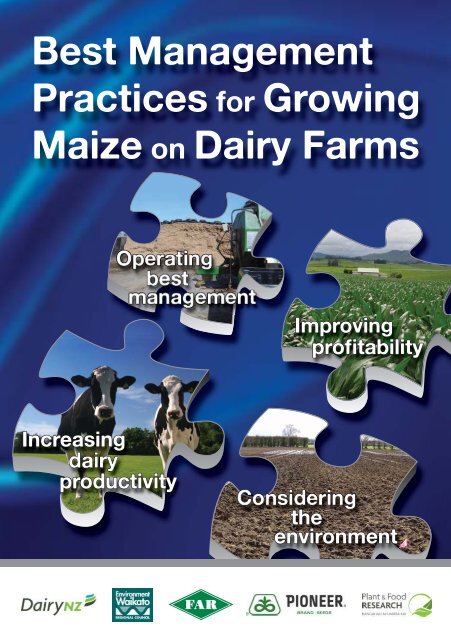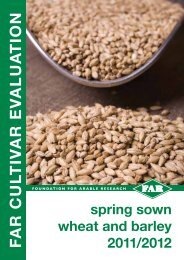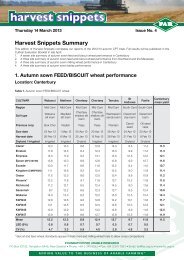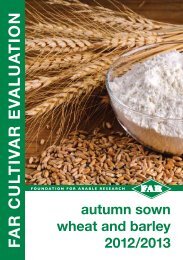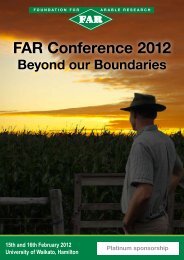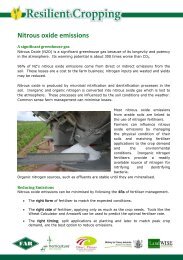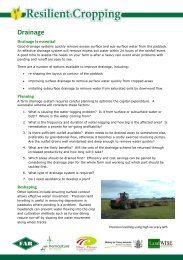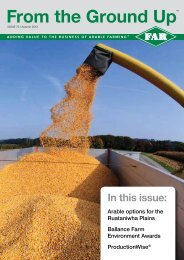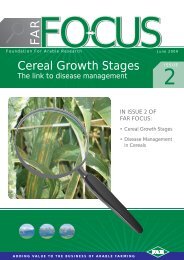Best Management Practices for Growing Maize on Dairy Farms
Best Management Practices for Growing Maize on Dairy Farms
Best Management Practices for Growing Maize on Dairy Farms
- No tags were found...
You also want an ePaper? Increase the reach of your titles
YUMPU automatically turns print PDFs into web optimized ePapers that Google loves.
<str<strong>on</strong>g>Best</str<strong>on</strong>g> <str<strong>on</strong>g>Management</str<strong>on</strong>g><str<strong>on</strong>g>Practices</str<strong>on</strong>g> <str<strong>on</strong>g>for</str<strong>on</strong>g> <str<strong>on</strong>g>Growing</str<strong>on</strong>g><str<strong>on</strong>g>Maize</str<strong>on</strong>g> <strong>on</strong> <strong>Dairy</strong> <strong>Farms</strong>OperatingbestImprovingprofitabilityIncreasingdairyproductivityC<strong>on</strong>sideringtheenvir<strong>on</strong>ment
AcknowledgementsThe project group gratefully acknowledge the individuals and organisati<strong>on</strong>slisted below <str<strong>on</strong>g>for</str<strong>on</strong>g> the time, knowledge and/or funding they have c<strong>on</strong>tributed.FundingMAF Sustainable Farming Fund<strong>Dairy</strong> NZEnvir<strong>on</strong>ment WaikatoFoundati<strong>on</strong> <str<strong>on</strong>g>for</str<strong>on</strong>g> Arable ResearchGenetic Technologies LTDAuthorsChris Glassey - <strong>Dairy</strong> NZGabriele Kaufler - Envir<strong>on</strong>ment WaikatoMike Parker - Foundati<strong>on</strong> <str<strong>on</strong>g>for</str<strong>on</strong>g> Arable ResearchAndrea Pears<strong>on</strong> - Foundati<strong>on</strong> <str<strong>on</strong>g>for</str<strong>on</strong>g> Arable ResearchIan Williams - Genetic TechnologiesPaul Johnst<strong>on</strong>e - Plant & Food ResearchDesign and PrintBNS Design & Print Ltd© Foundati<strong>on</strong> <str<strong>on</strong>g>for</str<strong>on</strong>g> Arable Research (FAR)DISCLAIMERThis publicati<strong>on</strong> is copyright to the Foundati<strong>on</strong> <str<strong>on</strong>g>for</str<strong>on</strong>g> Arable Research and may not be reproduced or copied in any <str<strong>on</strong>g>for</str<strong>on</strong>g>m whatsoeverwithout written permissi<strong>on</strong>.This booklet is intended to provide accurate and adequate in<str<strong>on</strong>g>for</str<strong>on</strong>g>mati<strong>on</strong> relating to the subject matters c<strong>on</strong>tained in it. It has beenprepared and made available to all pers<strong>on</strong>s and entities strictly <strong>on</strong> the basis that FAR, its researchers and authors are fully excludedfrom any liability <str<strong>on</strong>g>for</str<strong>on</strong>g> damages arising out of any reliance in part or in full up<strong>on</strong> any of the in<str<strong>on</strong>g>for</str<strong>on</strong>g>mati<strong>on</strong> <str<strong>on</strong>g>for</str<strong>on</strong>g> any purpose. Noendorsement of named products is intended nor is any criticism of other alternative, but unnamed product.
<str<strong>on</strong>g>Best</str<strong>on</strong>g> <str<strong>on</strong>g>Management</str<strong>on</strong>g><str<strong>on</strong>g>Practices</str<strong>on</strong>g> <str<strong>on</strong>g>for</str<strong>on</strong>g> <str<strong>on</strong>g>Growing</str<strong>on</strong>g><str<strong>on</strong>g>Maize</str<strong>on</strong>g> <strong>on</strong> <strong>Dairy</strong> <strong>Farms</strong>“<str<strong>on</strong>g>Maize</str<strong>on</strong>g> is a vital crop <str<strong>on</strong>g>for</str<strong>on</strong>g> many New Zealand dairy farmers; it also represents asignificant investment in time and resources. This booklet aims to give farmers thetools that they need to extract maximum value from this investment, providing the mosttopical in<str<strong>on</strong>g>for</str<strong>on</strong>g>mati<strong>on</strong> <strong>on</strong> maize crop preparati<strong>on</strong>, management and harvest, in <strong>on</strong>e easyto access resource.”C<strong>on</strong>tents1. Improving pastoral dairy farming using maize silage ....................22. Liaising with your c<strong>on</strong>tractor and technical advisor ......................53. The drivers of maize yield ..............................................................74. Site selecti<strong>on</strong> ..................................................................................95. Soil preparati<strong>on</strong> ............................................................................106. <str<strong>on</strong>g>Maize</str<strong>on</strong>g> nutrient requirements ........................................................127. Crop m<strong>on</strong>itoring ...........................................................................158. Harvest and post-harvest management ......................................189. <str<strong>on</strong>g>Maize</str<strong>on</strong>g> <str<strong>on</strong>g>for</str<strong>on</strong>g>age trading code of practice .........................................2010. Record keeping ............................................................................2111. Resources and further in<str<strong>on</strong>g>for</str<strong>on</strong>g>mati<strong>on</strong> ..............................................2212. Glossary .......................................................................................23Published by Foundati<strong>on</strong> <str<strong>on</strong>g>for</str<strong>on</strong>g> Arable Research (FAR) September 2009Tel: 03 325 6353 www.far.org.nzISBN: 978-0-9864533-3-5Versi<strong>on</strong> 1 - September 20091
1. Improving pastoraldairy farming usingmaize silage<str<strong>on</strong>g>Maize</str<strong>on</strong>g> grown <strong>on</strong> dairy farmsCan:• Add value to a farms feedsupply• Help mitigate climatic risk• Extract excess soil nutrientsfrom high fertility effluentpaddocksMust be:• Fed to fill genuine feed deficits<str<strong>on</strong>g>for</str<strong>on</strong>g> ec<strong>on</strong>omic resp<strong>on</strong>ses• Well managed to reduce feedcosts and wastagePasture is the major comp<strong>on</strong>ent of the NZdairy herd’s diet; however, opportunitiesexist to improve profit through the strategicuse of maize silage.The pastoral dairy farm is a balancebetween pasture supply and cow demand,which must be maintained to achieveefficient c<strong>on</strong>versi<strong>on</strong> of feed into milk andprofit. Unless well integrated with pasturesupply and feed demand, extra feeds suchas maize silage, will produce extra milk, butnot always extra profit.To use maize silage profitability farmersmust identify what they are trying to achievethrough its use. This requires working outthe key limiting factors <str<strong>on</strong>g>for</str<strong>on</strong>g> running an efficientand profitable grass-based systemand whether changes are in line with theirgoals. This can be d<strong>on</strong>e in c<strong>on</strong>juncti<strong>on</strong> witha farm c<strong>on</strong>sultant or <str<strong>on</strong>g>for</str<strong>on</strong>g>age specialist.Important factors <str<strong>on</strong>g>for</str<strong>on</strong>g> improving pastoraldairy farming using maize silage are:1. Ensure that the highest resp<strong>on</strong>sesare gained from the feed eatenA key driver of resp<strong>on</strong>se to additi<strong>on</strong>al feedis energy deficit, the difference betweenenergy demand and the actual energysupplied.Cows of high breeding worth ($BW), athigh stocking rates and with lactati<strong>on</strong>sl<strong>on</strong>ger than 260 days, are more likely to bein energy deficit, and will be more resp<strong>on</strong>siveto additi<strong>on</strong>al feeds such as maizesilage. Cows resp<strong>on</strong>d best to extra feed ifthe farm has a genuine feed deficit, createdthrough calving earlier, more days in milk orcarrying more cows per hectare.If all of the additi<strong>on</strong>al energy provided bysupplement is c<strong>on</strong>verted into milk, themaximum possible resp<strong>on</strong>se is 13 g MS/MJ metabolisable energy (ME). This isequivalent to 137 g MS/kg DM maize silage(assuming maize silage is 10.5 MJ ME/kgDM). In practice, resp<strong>on</strong>ses are usuallymuch lower than this due to feed lossesin transport, storage and feeding, the substituti<strong>on</strong>of supplement <str<strong>on</strong>g>for</str<strong>on</strong>g> pasture, thepartiti<strong>on</strong>ing of energy into liveweight gain(LWG) or the maintenance of extra cows.Trials in New Zealand have found producti<strong>on</strong>resp<strong>on</strong>ses to maize silage between 32g MS/kg DM and 178 g MS/kg DM. Thehighest resp<strong>on</strong>se came from more daysin milk created by feeding maize silage ina year affected by a dry summer. Analysisof more than 600 NZ dairy farms found <strong>on</strong>average, that supplements fed added <strong>on</strong>ly50 g MS/kg DM to annual milk solids percow and 96 g MS/kg DM to annual milksolids/ha. With such a variati<strong>on</strong> in resp<strong>on</strong>sepossible, attenti<strong>on</strong> to detail is required inorder to turn additi<strong>on</strong>al feed into additi<strong>on</strong>alprofit.2
6. Use maize silage to re-grasspaddocks<str<strong>on</strong>g>Maize</str<strong>on</strong>g> silage acts as a “break crop” <str<strong>on</strong>g>for</str<strong>on</strong>g> c<strong>on</strong>trollingperennial weeds such as couch andkikuyu, as well as reducing the populati<strong>on</strong>sof the clover root knot nematode and thewhite fringed weevil.In summary, growing maize <strong>on</strong> dairy farmscan be an important comp<strong>on</strong>ent of plannedimprovement of a farm’s feed supply, eitherdirectly through the high potential DM yieldof the maize crop itself and/or through theimproved pasture resulting from a plannedcropping rotati<strong>on</strong>.4
2. Liaising with yourc<strong>on</strong>tractor and technicaladvisor<str<strong>on</strong>g>Growing</str<strong>on</strong>g> maize requires a rangeof operati<strong>on</strong>s:• Most dairy farmers will needc<strong>on</strong>tractors to assist with someor all of these processes• Some c<strong>on</strong>tractors and technicaladvisors will offer a cropmanagement service• Communicati<strong>on</strong> and goodplanning are key to working withc<strong>on</strong>tractors and technicaladvisors<str<strong>on</strong>g>Growing</str<strong>on</strong>g> maize requires a range of operati<strong>on</strong>sfrom cultivati<strong>on</strong> through to harvest.Most dairy farmers w<strong>on</strong>’t have the specialistequipment required <str<strong>on</strong>g>for</str<strong>on</strong>g> growing maizeand will there<str<strong>on</strong>g>for</str<strong>on</strong>g>e need to employ c<strong>on</strong>tractors<str<strong>on</strong>g>for</str<strong>on</strong>g> these tasks.For those with limited time or experience,technical advisors from a range of merchantcompanies are available to offer crop managementservices and/or advice. There arespecialist c<strong>on</strong>tractors and advisors whoc<strong>on</strong>centrate <strong>on</strong> <strong>on</strong>ly <strong>on</strong>e aspect of maizeproducti<strong>on</strong> (e.g. spraying or fertilisers).Others provide a complete service fromsowing to harvest.The key to working with c<strong>on</strong>tractors andtechnical advisors is good communicati<strong>on</strong>.Most have several hundred clients requiringthe same service at much the same time.Notice of your intenti<strong>on</strong>s well in advanceand then regular updates will improve theservice they can provide. You will needto talk with your c<strong>on</strong>tractor and technicaladvisor regarding your specific requirements,which may include:1. SprayingYour spray c<strong>on</strong>tractor will need to knowyour sowing date so that they can planwhen to spray out pasture, and later whenherbicides will be required <str<strong>on</strong>g>for</str<strong>on</strong>g> the crop.M<strong>on</strong>itoring (chapter seven) will help determineif post emergence herbicides will beneeded.2. Cultivati<strong>on</strong>Your cultivati<strong>on</strong> c<strong>on</strong>tractor can adviseand outline costs of cultivati<strong>on</strong> methods;however, this will need to be d<strong>on</strong>e well inadvance of the projected planting date.(chapter five – Soil Preparati<strong>on</strong>)3. SowingYour sowing c<strong>on</strong>tractor will need advancewarning of both your intended sowingdate and your fertiliser program. SeedCompanies and Rural Supply firms will giveadvice <strong>on</strong> a suitable maize hybrid <str<strong>on</strong>g>for</str<strong>on</strong>g> yoursite, sowing date and planned harvest date.You should also discuss opti<strong>on</strong>s regardingseed treatment <str<strong>on</strong>g>for</str<strong>on</strong>g> pest c<strong>on</strong>trol.4. FertiliserEnsure you have a recent soil test, collectedfrom 0-15 cm deep from your intendedmaize paddock. Paddocks coming out ofl<strong>on</strong>g term pasture can supply up to 300kg N/ha just from soil organic matter, sosoil test <str<strong>on</strong>g>for</str<strong>on</strong>g> mineral nitrogen (0-60 cm) todetermine post sowing urea applicati<strong>on</strong>s.Technical advisors and fertiliser companiescan organise soil tests and develop fertiliserplans. (chapter seven - Crop M<strong>on</strong>itoring).There are a number of different methods offertiliser applicati<strong>on</strong>; bulk spreader <str<strong>on</strong>g>for</str<strong>on</strong>g> basefertiliser, sowing c<strong>on</strong>tractor <str<strong>on</strong>g>for</str<strong>on</strong>g> fertiliser5
applied through the drill, post emergence N- often referred to as side-dressing (knifingor broadcasting urea into the soil six toeight weeks after sowing). Your technicaladvisor will assist you in determining thebest method <str<strong>on</strong>g>for</str<strong>on</strong>g> your c<strong>on</strong>diti<strong>on</strong>s. (chaptersix <str<strong>on</strong>g>Maize</str<strong>on</strong>g> Nutrients)5. Harvesting<str<strong>on</strong>g>Maize</str<strong>on</strong>g> harvesting and stack building is anextremely busy and difficult time <str<strong>on</strong>g>for</str<strong>on</strong>g> c<strong>on</strong>tractors;with large hectares to harvest, ashort time frame and often adverse weatherto c<strong>on</strong>tend with.<str<strong>on</strong>g>Maize</str<strong>on</strong>g> is normally harvested between 30 to40% dry matter. Let your c<strong>on</strong>tractor knowyour preference well in advance.Determining maize silage maturity in thefield requires c<strong>on</strong>siderable experience.Generally harvest c<strong>on</strong>tractors will m<strong>on</strong>itorcrop maturity and determine harvest time.Technical advisors will also give guidance ifrequired. (chapter seven)Remember that stack sites and accessareas must be prepared be<str<strong>on</strong>g>for</str<strong>on</strong>g>e harvest.Aim to get this d<strong>on</strong>e early in case the cropmatures faster than expected.Post harvest planning e.g. sowing newpastures, is also crucial to c<strong>on</strong>tinuedsuccess. Again your technical representativewill be able to assist you with the bestopti<strong>on</strong>s <str<strong>on</strong>g>for</str<strong>on</strong>g> your site.6
3. The drivers of maizeyield<str<strong>on</strong>g>Maize</str<strong>on</strong>g> yield is affected by manyfactors:• Sowing locati<strong>on</strong>, sowing date,hybrid choice and populati<strong>on</strong> willall influence the potential yield ofthe crop• Potential yield can be reducedby weed and pest presence,moisture stress, disease andnutrient limitati<strong>on</strong>s<str<strong>on</strong>g>Maize</str<strong>on</strong>g> crops behave in a very predictablemanner, making it a very attractive crop<str<strong>on</strong>g>for</str<strong>on</strong>g> researchers to work with. There<str<strong>on</strong>g>for</str<strong>on</strong>g>e thedrivers of maize yield are well understood.Potential yield (the maximum possibleyield provided there are no limitati<strong>on</strong>s dueto; weed pressure, drought, water logging,nutrients, disease, and soil structure etc) isdriven by radiati<strong>on</strong> intercepti<strong>on</strong>.Radiati<strong>on</strong> (sunshine energy) is absorbedby the crop according to how much iscoming in, and how much green leaf areais available to intercept it. The radiati<strong>on</strong>is c<strong>on</strong>verted to biomass at a rate of 1.6 TDM/ha <str<strong>on</strong>g>for</str<strong>on</strong>g> every 100 MJ of radiati<strong>on</strong> intercepted.<str<strong>on</strong>g>Maize</str<strong>on</strong>g> is <strong>on</strong>e of the most efficientplants at doing this.Temperature is another factor which alsoinfluences potential yield, because it affectsthe rate of development (time to variousgrowth stages like leaf emergence andsilking). Temperature is used to calculate‘<str<strong>on</strong>g>Growing</str<strong>on</strong>g> Degree Days’ (GDD’s). Warmertemperatures mean crops reach maturityfaster.To maximise potential yield, we need tomaximise radiati<strong>on</strong> intercepti<strong>on</strong>. There arefour main factors that drive this; locati<strong>on</strong>,sowing time, hybrid and populati<strong>on</strong>.1. Locati<strong>on</strong>Temperature and radiati<strong>on</strong> are differentaround the country. The highest maize yieldsare often achieved in Gisborne, because ofthe high radiati<strong>on</strong> and l<strong>on</strong>g growing seas<strong>on</strong>in that regi<strong>on</strong>. Often our growing locati<strong>on</strong>is fixed, but if you are thinking of leasing orbuying land to grow maize <strong>on</strong>, you shouldinvestigate the climatic c<strong>on</strong>diti<strong>on</strong>s at thesite.2. Sowing timeThis affects radiati<strong>on</strong> intercepti<strong>on</strong>, as radiati<strong>on</strong>changes during the year. Radiati<strong>on</strong>peaks in late December, so aim to sow yourcrop so that you have full canopy coverby this stage, to maximise the use of thisradiati<strong>on</strong>.In general, earlier sown crops tend to yieldbetter than later sown crops (Figure 1).However sowing time needs to be balancedagainst many other factors such as; frostrisk, soil c<strong>on</strong>diti<strong>on</strong>s and any pasture silagethat you wish to harvest off the paddock.Figure 1. Effect of sowing time <strong>on</strong> potential yield<str<strong>on</strong>g>for</str<strong>on</strong>g> a medium seas<strong>on</strong> maize silage crop grown inthe Waikato.7
3. HybridThere are many different maize hybridsavailable. The main differences betweenhybrids are:• The number and size of leaves (whichaffects green leaf area and henceradiati<strong>on</strong> intercepti<strong>on</strong>).• Crop maturity or the number of GDD’sbe<str<strong>on</strong>g>for</str<strong>on</strong>g>e the crop is ready to harvest.• Their ability to cope with stresses suchas disease or drought.Your choice of hybrid will ultimately depend<strong>on</strong>; where you are, when you want to sow,and when you want to harvest. Your seedsales representative can help you select asuitable hybrid.As a general guide, short seas<strong>on</strong> hybridstend to yield less because they have fewerand smaller leaves than l<strong>on</strong>g seas<strong>on</strong>hybrids (intercept less radiati<strong>on</strong>). They als<strong>on</strong>eed fewer GDD’s to reach maturity, sothey are in the ground <str<strong>on</strong>g>for</str<strong>on</strong>g> fewer days, andhence absorb less radiati<strong>on</strong>.4. Plant populati<strong>on</strong>Populati<strong>on</strong> affects radiati<strong>on</strong> intercepti<strong>on</strong> asmore plants means more leaf area. Typicalpopulati<strong>on</strong>s <str<strong>on</strong>g>for</str<strong>on</strong>g> maize silage is 100 to 120thousand (K) seeds per hectare (there are80 K seeds in a bag) and your seed salesrepresentative will advise you <strong>on</strong> the bestpopulati<strong>on</strong> <str<strong>on</strong>g>for</str<strong>on</strong>g> your situati<strong>on</strong>. Final populati<strong>on</strong>sare normally 5 K/ha less than whatwas originally sown.Other factors affecting potential yieldPotential yield assumes there is no limitati<strong>on</strong>to the stresses that comm<strong>on</strong>ly affectmaize yields. In reality, this is seldom true.Weed pressure can reduce maize yield byup to 30%, make harvest difficult and c<strong>on</strong>taminatesilage. M<strong>on</strong>itor crops <str<strong>on</strong>g>for</str<strong>on</strong>g> weedsand take acti<strong>on</strong> early as many weeds cangrow faster than maize seedlings.Drought will reduce maize yield by 22 kgDM/ha <str<strong>on</strong>g>for</str<strong>on</strong>g> every 1 mm of potential soilmoisture deficit (the difference betweenwhat a crop needs and what it gets).Because maize has deep roots (up to 1.8m), few maize crops are irrigated exceptif grown in dry envir<strong>on</strong>ments and/or <strong>on</strong>shallow soils.Water logging reduces the plant’s abilityto take up nutrients, and creates a toxic soilenvir<strong>on</strong>ment <str<strong>on</strong>g>for</str<strong>on</strong>g> plant roots, since the soilcannot ‘breathe’ and release gases createdby soil microbial activity. Prol<strong>on</strong>ged waterlogging can cause large losses in maizeyields.The nutrient requirements <str<strong>on</strong>g>for</str<strong>on</strong>g> maize willbe covered in chapter six. The nutrientmost likely to limit maize yields is nitrogen.Soil nitrogen is generally low in paddockswith a l<strong>on</strong>g history of cropping, but veryhigh in paddocks coming out of l<strong>on</strong>g termpasture.The main leaf diseases of maize arecomm<strong>on</strong> rust, eyespot and northern cornleaf blight. Severe infecti<strong>on</strong> can reduceyields by 30%. Only in very disease pr<strong>on</strong>ec<strong>on</strong>diti<strong>on</strong>s (warm and humid, together witha hybrid of lower disease resistance) willthe applicati<strong>on</strong> of fungicides be ec<strong>on</strong>omicallybeneficial.Pests can also affect yield. Argentine StemWeevil (ASW), Greasy Cutworm and BlackBeetle can be a problem particularly ifdirect drilling or strip tilling. (chapter seven- Crop M<strong>on</strong>itoring)Soil structure tends to deteriorate withrepeated cultivati<strong>on</strong>. Compacti<strong>on</strong> reducessoil aerati<strong>on</strong> and aggregati<strong>on</strong>, affecting theability of plant roots to extract water andnutrients from the soil. Paddocks <str<strong>on</strong>g>for</str<strong>on</strong>g>merlyin l<strong>on</strong>g term pasture generally have goodsoil structure.8
4. Site selecti<strong>on</strong>• Paddock selecti<strong>on</strong> is important interms of:- Access <str<strong>on</strong>g>for</str<strong>on</strong>g> large maizemachinery- Yield potential- Cost of producti<strong>on</strong> and harvest- Envir<strong>on</strong>mental impacts• C<strong>on</strong>sult with your c<strong>on</strong>tractor(s)be<str<strong>on</strong>g>for</str<strong>on</strong>g>e finalising your siteselecti<strong>on</strong>Many dairy farmers use maize grown <strong>on</strong>farm as part of their pasture renewal programme.However, not all such paddocksare suited <str<strong>on</strong>g>for</str<strong>on</strong>g> maize producti<strong>on</strong>.• Very steep paddocks (often also withwetter gullies) not <strong>on</strong>ly make cultivati<strong>on</strong>and harvesting difficult and hazardous,but also tend to not yield as well.• Low lying wetter paddocks will oftenmean delays in cultivati<strong>on</strong> after adverseweather. Again these often do not yieldas well, unless drought c<strong>on</strong>diti<strong>on</strong>sprevail.• A paddock which is wet with a grasssward, acts as if 10% wetter when thestructural strength of the sward isremoved by cultivati<strong>on</strong>.• Wet paddocks risk a loss of soilstructure under cultivati<strong>on</strong> which in turnleads to lower yields.Many l<strong>on</strong>g term effluent paddocks have highN and K levels and there<str<strong>on</strong>g>for</str<strong>on</strong>g>e are ideal <str<strong>on</strong>g>for</str<strong>on</strong>g>growing a deep rooting crop of maize oftenwithout using any bagged fertiliser (chaptersix). While this often means herds have towalk further while the effluent paddock isout of rotati<strong>on</strong>, the opportunity <str<strong>on</strong>g>for</str<strong>on</strong>g> reducedgrowing costs and envir<strong>on</strong>mental benefitsshould be c<strong>on</strong>sidered. Many l<strong>on</strong>g termdairy pastures also have a fertility level thatmeans N fertiliser inputs <str<strong>on</strong>g>for</str<strong>on</strong>g> maize cropssown from pasture can be reduced withoutmaize yield reducti<strong>on</strong>s.It is also important to c<strong>on</strong>sider the locati<strong>on</strong>in terms of protecti<strong>on</strong> of sensitive areasi.e. streams, lakes, wetlands and drains(chapter five)To grow high quality maize silage <strong>on</strong> farm<str<strong>on</strong>g>for</str<strong>on</strong>g> the least cost, c<strong>on</strong>sider the factorsthat make a c<strong>on</strong>tractor’s job speedy andefficient.Paddock access is also very important,the distance from the paddock to stackwill reflect in the harvest cost. Cartagecosts from distant runoffs will be greatest;however narrow, rough farm tracks withpoor access will also mean higher costs.<str<strong>on</strong>g>Maize</str<strong>on</strong>g> cultivati<strong>on</strong> equipment and harvestersare wide, l<strong>on</strong>g, and heavy, requiring gatewidths of at least 4 m with ample turningroom, unless fences can be dropped.Bridges or culvert crossings need to beof sufficient strength to hold the weight ofheavy vehicles and (at harvest) their loads.Low hanging overhead wires should beraised, or at least temporarily removed.C<strong>on</strong>sult your c<strong>on</strong>tractor prior to finalisingyour site they can assist you in selectingthe best paddock to sow in maize.9
5. Soil preparati<strong>on</strong>• The soil provides water andnutrients to the crop, but poorlymanaged cultivati<strong>on</strong> can damagesoil and affect crop yields• Factors to c<strong>on</strong>sider are:- Soil type and suitability <str<strong>on</strong>g>for</str<strong>on</strong>g>cultivati<strong>on</strong>- Adjacent sensitive areas (e.g.waterways)- Quality of the final seed bed(uni<str<strong>on</strong>g>for</str<strong>on</strong>g>mity of surface andaggregate size)- Intensity of cultivati<strong>on</strong>, includingthe pros and c<strong>on</strong>s of ploughingThe soil provides water and nutrients <str<strong>on</strong>g>for</str<strong>on</strong>g>plant growth; there<str<strong>on</strong>g>for</str<strong>on</strong>g>e, a healthy (structurallysound and biologically active) soil isimportant <str<strong>on</strong>g>for</str<strong>on</strong>g> crop producti<strong>on</strong>.Cultivati<strong>on</strong> serves many purposes in cropestablishment.• Creating a uni<str<strong>on</strong>g>for</str<strong>on</strong>g>m seed bed• Relieving compacti<strong>on</strong> (e.g. from stocktreading) and improving aerati<strong>on</strong>• Incorporating residues and weeds• Warming and drying the soil• Incorporating lime and fertilisersPoorly timed or managed cultivati<strong>on</strong> candamage soil, cause compacti<strong>on</strong> anderosi<strong>on</strong> problems, and ultimately affectcrop producti<strong>on</strong>. This is most likely to occurwhen the soil is too wet or too dry.Some of the key steps <str<strong>on</strong>g>for</str<strong>on</strong>g> successful cultivati<strong>on</strong>are outlined here:1. Understand your soil resourceHow your soil resp<strong>on</strong>ds to cultivati<strong>on</strong>will depend <strong>on</strong> the soil type and texture,plus any limitati<strong>on</strong>s it may have such asrisk of erosi<strong>on</strong> and water logging. Yourregi<strong>on</strong>al council can help you to identifyyour soil type and any limitati<strong>on</strong>s it has <str<strong>on</strong>g>for</str<strong>on</strong>g>cropping.2. Identify sensitive areasSoil can run off into water ways during highrainfall events, creating erosi<strong>on</strong> and waterquality issues. Most regi<strong>on</strong>al councils haveguidelines <str<strong>on</strong>g>for</str<strong>on</strong>g> how close you can cultivateto a waterway. If you need to leave a bufferz<strong>on</strong>e around the edge of your cultivatedz<strong>on</strong>e, d<strong>on</strong>’t spray it out as weeds will establishinstead. Rank grass vegetati<strong>on</strong> will actas a filter and help trap potential run off.3. Soil surface<str<strong>on</strong>g>Maize</str<strong>on</strong>g> seed is normally sown around 5 cmdeep. An uneven soil surface (undulati<strong>on</strong>s,ruts etc) makes it difficult <str<strong>on</strong>g>for</str<strong>on</strong>g> the planter toplace the seed at a uni<str<strong>on</strong>g>for</str<strong>on</strong>g>m depth, resultingin variable emergence. Very cloddysoil or large ruts can cause the planter tobounce, causing variability in seed depthand spacing.4. Aggregate size<str<strong>on</strong>g>Maize</str<strong>on</strong>g> does not need a very fine seedbed.It is a large seed and seed to soil c<strong>on</strong>tact isgenerally sufficient <str<strong>on</strong>g>for</str<strong>on</strong>g> germinati<strong>on</strong>, exceptin very cloddy soils. Light rolling aftersowing may help improve the seed-soilc<strong>on</strong>tact, seal in moisture and reduce therisk of wind erosi<strong>on</strong>.5. Minimal cultivati<strong>on</strong>Excessive cultivati<strong>on</strong> weakens the soil andaccelerates loss of soil organic matter.Keep cultivati<strong>on</strong> to a minimum and avoidcultivati<strong>on</strong> when the soil is too wet or too dry.10
6. Should I plough?Ploughing is a quick effective way to buryplant residues that might otherwise impedesec<strong>on</strong>dary cultivati<strong>on</strong> or cause weedproblems. However a comment we oftenhear from dairy farmers is that maize is ‘hard<strong>on</strong> the soil’ and <strong>on</strong>e of the main causes ofthis is associated with ploughing.Pastoral farmers invest a lot of m<strong>on</strong>ey infertiliser to improve the nutrient levels inthe top 7.5 cm of their soil. If that topsoilis then buried at 20 cm by ploughing, thensubsequent soil tests will show lower fertility.Those nutrients are still there but nowbelow the 7.5 cm soil sampling depth andout of reach of the new grass trying toestablish after maize.Talk with your c<strong>on</strong>tractor about alternativesto ploughing, such a discing. Be aware thatyou may need a l<strong>on</strong>ger fallow period (timebetween spraying out pasture and firstcultivati<strong>on</strong> pass), but you need to balancethis against the l<strong>on</strong>g term damage to yoursoil fertility. C<strong>on</strong>versely, ploughing may bea remedial opti<strong>on</strong> if your topsoil nutrientsare too high (chapter six).There are other reduced tillage opti<strong>on</strong>s<str<strong>on</strong>g>for</str<strong>on</strong>g> maize such as strip tillage and directdrilling, but these require more attenti<strong>on</strong>to details and are best suited <str<strong>on</strong>g>for</str<strong>on</strong>g> specialistmaize growers.11
6. <str<strong>on</strong>g>Maize</str<strong>on</strong>g> nutrientrequirements• <str<strong>on</strong>g>Maize</str<strong>on</strong>g> requires substantialnitrogen (N) and potassium (K),both of which are present in largeamounts in dairy soils• Up to 300 kg N/ha is releasedfrom soil organic matter whenhigh fertility dairy pastures arecultivated• <str<strong>on</strong>g>Maize</str<strong>on</strong>g> is unlikely to resp<strong>on</strong>d to Kfertiliser unless soil K test levelsare very low. Replacement Kfertiliser can be applied afterharvest to avoid luxury uptake bythe maize crop• Soil test <str<strong>on</strong>g>for</str<strong>on</strong>g> N be<str<strong>on</strong>g>for</str<strong>on</strong>g>e applyingpost emergence N fertiliser todetermine if any is required• <strong>Dairy</strong> effluent can be used asa nutrient source <str<strong>on</strong>g>for</str<strong>on</strong>g> maize,provided that the crop requiresthe nutrients and good effluentmanagement practices arefollowedCropping and dairy farmers often havedifferent approaches to fertiliser management.Cropping farmers will estimate whatthe crop needs, measure how much isalready available, and then determine howmuch extra is needed. Pastoral farmers aremore focussed <strong>on</strong> reaching optimum levelsof soil fertility, then maintaining them usinga nutrient replacement policy.A nutrient replacement approach <str<strong>on</strong>g>for</str<strong>on</strong>g> maizegrown <strong>on</strong> dairy farms does not work well,<str<strong>on</strong>g>for</str<strong>on</strong>g> two main reas<strong>on</strong>s.• <str<strong>on</strong>g>Maize</str<strong>on</strong>g> can access nutrients from rightthrough the soil profile, not just the top7.5 cm. Deeper nutrients are availableto maize but not to grass, so why notuse them?• Cultivati<strong>on</strong> of pasture paddocksreleases large amounts of nutrient,particularly nitrogen.The upside of both is a huge saving in fertiliserinputs.1. Nutrient uptake by maize silageThe average maize silage crop c<strong>on</strong>tainsabout 1.1% nitrogen (N), 0.2% phosphorus(P) and 1.2% potassium (K). This means amaize silage crop yielding 20 T DM/ha willtake up around 220 kg N, 40 kg P and 240kg K. It does not mean this is how muchfertiliser we need to apply. Let’s go througheach of these nutrients separatelyNitrogen (N)Of all the nutrients used <strong>on</strong> cropping farms,N is most likely to limit maize yields and istypically the largest fertiliser input. TypicalN inputs <str<strong>on</strong>g>for</str<strong>on</strong>g> maize would be 20-50 kg N/haapplied at sowing and around 100-200 kgN/ha applied as urea six to eight weeks later(post emergence N, sometimes referred toas side-dressing).These inputs are generally not needed <str<strong>on</strong>g>for</str<strong>on</strong>g>maize grown in dairy paddocks comingout of l<strong>on</strong>g term pasture. Over the pasttwo seas<strong>on</strong>s, we have m<strong>on</strong>itored maizegrown in nine dairy paddocks, both withand without a history of effluent applicati<strong>on</strong>.Results have been c<strong>on</strong>sistent. Wefound no resp<strong>on</strong>se to N fertiliser at any sitebecause we measured up to 300 kg N/hareleased by the soil, enough to meet croprequirements.You may still chose to apply a small amountof fertiliser at sowing, however, in the firstyear out of grass there is no need to applyfurther N fertiliser to maize crops grown indairy pastures. If in doubt, get your fertiliserrep to collect a deep N soil sample (60 cm)12
<str<strong>on</strong>g>for</str<strong>on</strong>g> mineral N be<str<strong>on</strong>g>for</str<strong>on</strong>g>e you apply any postemergence N. The AmaizeN N fertiliser<str<strong>on</strong>g>for</str<strong>on</strong>g>ecaster can help interpret the results.Phosphorus (P)How can such a huge crop use such asmall amount of P? Phosphorus is used byplants <str<strong>on</strong>g>for</str<strong>on</strong>g> root growth, nutrient uptake andgrain development. <str<strong>on</strong>g>Maize</str<strong>on</strong>g> is highly efficientat using P. The removal of 40 kg P/ha by amaize crop will barely register in a soil test.Your cultivati<strong>on</strong> practices are likely to havea bigger impact (chapter five).Most growers apply a small amount of Pat sowing. Recent trials <strong>on</strong> maize silagegrown <strong>on</strong> dairy farms showed that eventhough the seedlings looked smaller whereno P fertiliser was used, there was no effect<strong>on</strong> final yield.How much P fertiliser you apply will depend<strong>on</strong> your soils’ Olsen P status and whetheryou want to increase, maintain or decreaseit. Discuss your l<strong>on</strong>g term plans <str<strong>on</strong>g>for</str<strong>on</strong>g> thepaddock with your fertiliser rep.Help, my crop has turned purple!!This purple discolourati<strong>on</strong> sometimesseen in maize seedlings is often attributedto P deficiency, but is more likely due tosome other stress such as the cold orwet. Certain hybrids are more pr<strong>on</strong>e topurpling. In the vast majority of cases, thecrop will grow through the stress with nopermanent effects.Potassium (K)<str<strong>on</strong>g>Maize</str<strong>on</strong>g> silage is around 1.2% K (a 20 T DMcrop uses 240 kg K) but unless you havelow soil K levels (
3. Can I use dairy effluent <str<strong>on</strong>g>for</str<strong>on</strong>g>fertiliser?In short, yes. The ratio of NPK in maize issimilar to that found in dairy shed effluent,so they make a good match. Early resultssuggest that about half of the nutrientsapplied as effluent are available to themaize crop in the year of applicati<strong>on</strong>.However, as with any fertiliser, we need toestablish whether the crop or soil requiresthese additi<strong>on</strong>al nutrients.If the paddock is just out of grass, thesoil can supply plenty of N and furtheradditi<strong>on</strong>s through effluent are probablynot needed. Paddocks with a history ofcropping (e.g. a dedicated cropping blockor run off) are most likely to benefit fromeffluent applicati<strong>on</strong>.If you are applying effluent to your maizecrop, then follow good practice.• Test your effluent <str<strong>on</strong>g>for</str<strong>on</strong>g> nutrient c<strong>on</strong>tentprior to applicati<strong>on</strong>, so you can calculatean appropriate applicati<strong>on</strong> rate.However, be aware that this will be arough estimate as effluent nutrientc<strong>on</strong>tent is highly variable. The maximumloading to cropping ground in theWaikato is 200 kg N/ha/year as effluent.• Check how much is actually applied.Put c<strong>on</strong>tainers in the paddock duringapplicati<strong>on</strong> and measure the depth. Youcan multiply the volume applied by thenutrient c<strong>on</strong>tent to determine how muchtotal nutrient was applied.• Ensure there is no p<strong>on</strong>ding or run offduring applicati<strong>on</strong>. You may need tomake multiple passes to apply theamount you want.cause metabolic problems in cattle. <str<strong>on</strong>g>Maize</str<strong>on</strong>g>can be successfully grown <strong>on</strong> effluentblocks with high soil fertility without the useof additi<strong>on</strong>al fertiliser.<str<strong>on</strong>g>Maize</str<strong>on</strong>g> will take up K from the soil and if it isfed out around the farm, then the nutrientswill be redistributed around the farm. If themaize is fed <strong>on</strong> a feed pad with wash downinto the effluent system, then the nutrientswill end up back <strong>on</strong> the effluent block.Soil cultivati<strong>on</strong> associated with growinga maize crop can redistribute nutrientsthrough the soil. Ploughing will move topsoilnutrients to depth, so this may be an opti<strong>on</strong>if your soil K levels are excessively high.4. <str<strong>on</strong>g>Growing</str<strong>on</strong>g> maize <strong>on</strong> the effluentblockL<strong>on</strong>g term applicati<strong>on</strong> of effluent increasessoil K levels. Pastures with high K levels can14
7. Crop m<strong>on</strong>itoring• M<strong>on</strong>itoring is an important partof good management to maximiseyield• A good m<strong>on</strong>itoring programmeshould include:- Weeds, pests and diseases- Soil N sampling- Soil moisture if irrigating- Crop maturity• C<strong>on</strong>tractors and technicaladvisors can undertake someor all of this m<strong>on</strong>itoringapplicati<strong>on</strong>, delayed applicati<strong>on</strong> or perennialweeds can mean that further post emergenceapplicati<strong>on</strong>s are required. Choice ofchemical will depend <strong>on</strong> what weeds arepresent and their growth stage, there<str<strong>on</strong>g>for</str<strong>on</strong>g>em<strong>on</strong>itoring is vital. Paddocks out of l<strong>on</strong>gterm pasture often have a greater broadleaf weed seed bank than grass weeds andthere<str<strong>on</strong>g>for</str<strong>on</strong>g>e omitting a grass weed herbicide(chloroacetamide) from the mix might beworthwhile. However, run out pastures oftenhave (<str<strong>on</strong>g>for</str<strong>on</strong>g> example) summer grass weedseed present and there<str<strong>on</strong>g>for</str<strong>on</strong>g>e the additi<strong>on</strong> of achloroacetamide would be necessary.3. Emergence to four leaves (V4)In order to anticipate or rectify problemsand maximise yield it is necessary tom<strong>on</strong>itor crops regularly, particularly in thefirst two m<strong>on</strong>ths of growth. For the busydairy farmer, technical advisors and somec<strong>on</strong>tractors will provide this service.1. EmergencePaddocks need to be checked <str<strong>on</strong>g>for</str<strong>on</strong>g> slugs,bird, rabbit and rat damage. Slugs aregenerally not a problem where intensivecultivati<strong>on</strong> has been carried out but cando serious damage during wet weatherand if reduced tillage practices have beenused. Leaf damage and slime trails are agood c<strong>on</strong>firmati<strong>on</strong> of slug presence. Birdand rat damage is characterised by plantspulled and the seed embryo eaten. Missedplanted rows or poor populati<strong>on</strong> areasshould be noted at this time and if practical,rectified.2. WeedsWeeds in maize crops can cause significantyield loss and moisture activated preemergenceherbicides generally per<str<strong>on</strong>g>for</str<strong>on</strong>g>mvery well. However, dry c<strong>on</strong>diti<strong>on</strong>s afterNote four leaves with clearly visible collars.C<strong>on</strong>tinue m<strong>on</strong>itoring <str<strong>on</strong>g>for</str<strong>on</strong>g> slug and birddamage but also to check <str<strong>on</strong>g>for</str<strong>on</strong>g> greasycutworm and weeds. Greasy cutwormfeed at night by typically cutting and fellingmaize plants. Their presence can be c<strong>on</strong>firmedby digging around the base of freshlyfelled plants or examining plants near dusk.Spraying with a synthetic pyrethroid insecticideat dusk gives good c<strong>on</strong>trol.Greasy cutworm15
Deep soil (0-60 cm) mineral N testing canalso be carried out while pest and weedm<strong>on</strong>itoring (chapter six) to plan post emergencefertiliser N applicati<strong>on</strong>.4. Six leaves with visible collars (V6)From V6, the crop grows very rapidly andwith time eliminates vehicle access intothe crop. High clearance sprayers or aerialapplicati<strong>on</strong> become the <strong>on</strong>ly opti<strong>on</strong>s.If further N fertiliser is required, thenmake sure it is applied by this growthstage. M<strong>on</strong>itoring can also be d<strong>on</strong>e duringfertiliser applicati<strong>on</strong> and sometimes postemergenceherbicide applicati<strong>on</strong>s are alsoapplied with the fertiliser.5. Mid to late DecemberLeaf diseases (if warm and humid) appearduring this time. M<strong>on</strong>itoring <str<strong>on</strong>g>for</str<strong>on</strong>g> comm<strong>on</strong>rust, eyespot, and northern corn leaf blight(more comm<strong>on</strong> in l<strong>on</strong>g term maize land) isimportant if less resistant hybrids have beenused. Fungicides will give c<strong>on</strong>trol but areseldom used unless envir<strong>on</strong>mental c<strong>on</strong>diti<strong>on</strong>sare particularly favourable to disease.Generally around the 20-30th December isthe time to check <str<strong>on</strong>g>for</str<strong>on</strong>g> army worm caterpillarespecially if crops are weedy. Note thatcorn earworm often appears in Januaryas the cobs are pollinated. They are generallyc<strong>on</strong>trolled by parasitic wasps. Cornearworm should not be c<strong>on</strong>fused witharmyworm.Armyworm caterpillars - green, then greenishbrown when older.Corn earworm.6. Irrigati<strong>on</strong>While generally not practised in most NorthIsland dairy regi<strong>on</strong>s, irrigati<strong>on</strong> is comm<strong>on</strong> inCanterbury. Inadequate moisture (when thesoil moisture falls below half the soil waterholding capacity) at any growth stage canreduce maize yield. It is advisable to run awater budget or schedule based <strong>on</strong> 50%of plant available moisture linked to weekly16
evapotranspirati<strong>on</strong> rates (ET). Moisturestress can also result in a lack of synchr<strong>on</strong>isati<strong>on</strong>between pollen shed and silking atpollinati<strong>on</strong>.7. Silking dateOne important maturity indicator is themaize kernel milkline, where the milkyliquid changes to the harder darker starchline. By simply snapping a cob in two andexamining the upper porti<strong>on</strong>’s kernels, themilkline can be seen. When the milkline is<strong>on</strong>e third of the way up from the bottom ofthe kernel the plant is in the 28 to 32% DMrange. However, other indicators need tobe c<strong>on</strong>sidered (including those menti<strong>on</strong>edearlier) such as the hybrid, the husk covercolour, the greenness of the leaves andstem.Silking date is the date when 50% of the plantsare showing silk at the tip of the young embry<strong>on</strong>iccob.1/ 3 rd Liquid milkThe date when 50% of the plants are silking(refer to photo) should be noted. <str<strong>on</strong>g>Maize</str<strong>on</strong>g>generally takes 50-55 days from this timeto reach two thirds milkline, an importantindicator of crop maturity.<str<strong>on</strong>g>Maize</str<strong>on</strong>g> kernel milkline.2/ 3 rds Solid starch8. Three weeks prior to harvestIt is vital that crops are checked <str<strong>on</strong>g>for</str<strong>on</strong>g> harvestmaturity. The AmaizeN calculator and 50%silking date will greatly aid in determiningwhen to start frequent m<strong>on</strong>itoring. Goodquality maize silage is best made when thewhole plant Dry Matter (DM) is between 30and 40 %. If harvested at less than 30%DM, silage in the stack will be wet resultingin high stack leachate, this leachate representsnutrient loss. If greater than 40%DM, stack compacti<strong>on</strong> and air exclusi<strong>on</strong> ismuch more difficult.In-field estimati<strong>on</strong> of crop DM requiresc<strong>on</strong>siderable experience as; changes insoil type, topography, proximity to trees orhedges, the hybrids cob to stover (vegetativeparts) ratio and time of day, all need tobe taken into account. However, by examiningplants in representative areas goodestimates can be made.Most c<strong>on</strong>tractors and technical advisorshave experience in harvest scheduling.<strong>Dairy</strong> farmers would be wise to seek theiradvice in this area.17
8. Harvest and postharvestmanagement• Once ensiled maize silagedeteriorates when exposed to airTo minimise losses:- Carefully c<strong>on</strong>sider stacklocati<strong>on</strong> and prepare the site inadvance of harvest- Design the stack to minimisethe amount of maize exposedwhile the stack is being fed out- Minimise disturbing ordamaging the stack face tomaintain compacti<strong>on</strong><str<strong>on</strong>g>Maize</str<strong>on</strong>g> silage is full of soluble carbohydratewhich while being a great food <str<strong>on</strong>g>for</str<strong>on</strong>g> cows, isalso loved by spoilage bugs, such as yeastsand moulds. Yeasts and moulds needoxygen to survive. The aim of the ensilingprocess is to get air out of the stack andkeep it out until the maize silage is readyto be fed.1. Storing maize silageChoosing a siteYou need to make sure that the stack is wellsited.• Locate it close to the area where themaize will be fed.• Ensure that it is far enough away frombanks, fences, walls and trees to allowtractors room to run off the stack whilethey are building it.• Choose an area which is free draining.• If you need to lay down a metal or limepad ensure that this is d<strong>on</strong>e in advanceand well compacted.• Bait the area with rat bait <str<strong>on</strong>g>for</str<strong>on</strong>g> at leasttwo weeks prior to the maize beingharvested.• C<strong>on</strong>sider envir<strong>on</strong>mental implicati<strong>on</strong>s, <str<strong>on</strong>g>for</str<strong>on</strong>g>example: polluti<strong>on</strong> risk from runoff ofstack leachate, distance to waterways,drains and other sensitive areas.Stack typesOne issue to c<strong>on</strong>sider is to whether to usea bun (stack) or a bunker. Buns can belocated around the farm and are there<str<strong>on</strong>g>for</str<strong>on</strong>g>emore flexible, whereas bunkers are initiallymore expensive, BUT have higher compacti<strong>on</strong>rates and there<str<strong>on</strong>g>for</str<strong>on</strong>g>e less wastageYour storage c<strong>on</strong>tractor will be able toassist <strong>on</strong> the best method <str<strong>on</strong>g>for</str<strong>on</strong>g> your farm.Building the stackStack dimensi<strong>on</strong> depends <strong>on</strong> how muchmaize you are going to stack, how manyanimals you have and what inoculant youare using. The aim is to build a stack sothat when being fed out, as little maize aspossible is exposed to air, <str<strong>on</strong>g>for</str<strong>on</strong>g> as short atime as possible. There<str<strong>on</strong>g>for</str<strong>on</strong>g>e, a taller stack isbetter than lower <strong>on</strong>e and narrower stack isbetter than wider <strong>on</strong>e. Ideally it should takeno more than three days to feed across thestack face, taking out about half a metreeach feed.As the stack is being built make sure thatthe maize is being layered no deeper than150 mm deep.Covering and sealingCover the stack with the highest qualitycover you can af<str<strong>on</strong>g>for</str<strong>on</strong>g>d, immediately after thec<strong>on</strong>tractor has finished rolling the maizesilage. Seal around the base of the stackwith soil, sand or lime and place tyres overthe top of the stack. Ensure that there aresufficient tyres to cover the stack completely,with no gaps between the tyres.If birds are a problem, cover the wholeensiled stack with shade cloth, this is light,cheap and effective.18
2. Feeding out maize silageStarting feedingOpen the stack at the opposite end tothe prevailing wind to prevent air gettingpushed under the cover. Use a fr<strong>on</strong>t endloader to create a face. Once the face hasbeen created, chip away from the top of thestack, rather than lifting up from the bottomof the stack face. Do not ram the bucketor silage <str<strong>on</strong>g>for</str<strong>on</strong>g>ks into the face of the stack asthis creates shatter and may allow air topenetrate into the maize stack.Heavy rainfall can also pose a risk if thewater gets into the stack creating a polluti<strong>on</strong>risk through leachate.Face managementEnsure that the face is left tight daily, withno loose material at the base of the stack.A wide mouth shovel and a broom willhelp prevent this. You do not need to dropthe cover down over the face each day. Ifbirds are a problem use shade cloth or birdnetting to cover the face of the stack witha few tyres top and bottom to prevent thewind lifting it.Closing a stack downUse a fr<strong>on</strong>t end loader to remove any loosematerial from the fr<strong>on</strong>t of the stack, trimup the face using an old chainsaw, andthen spray a saturated salt soluti<strong>on</strong> overthe stack face. Drop the silage cover backdown over the face, reseal the base withsoil, and place tyres against the coveredface. Replenish all the bait stati<strong>on</strong>s aroundthe stack and leave the stack until you needto feed out again. It is a simple matter ofrolling the cover back up, removing anymaterial that may have become mouldyand feeding out again.19
9. <str<strong>on</strong>g>Maize</str<strong>on</strong>g> <str<strong>on</strong>g>for</str<strong>on</strong>g>age tradingcode of practice• The ‘<str<strong>on</strong>g>Maize</str<strong>on</strong>g> Forage Trading Codeof Practice’ has been designed tosafeguard both the buyer andseller of maize• Standard protocols <str<strong>on</strong>g>for</str<strong>on</strong>g> weighing,sampling and testing have beendeveloped <str<strong>on</strong>g>for</str<strong>on</strong>g> trading <strong>on</strong> a dryweight basis (kg DM)• These protocols can be used<str<strong>on</strong>g>for</str<strong>on</strong>g> determining the total DM yieldof your stack <str<strong>on</strong>g>for</str<strong>on</strong>g> feed budgetingpurposesIf you are buying or selling maize silage,you should be aware of the ‘<str<strong>on</strong>g>Maize</str<strong>on</strong>g> ForageTrading Code of Practice’, which has beendesigned to safeguard both the buyer andseller of maize. Developed by c<strong>on</strong>tractorsand industry groups, the code outlinesbest practice <str<strong>on</strong>g>for</str<strong>on</strong>g> trading maize <str<strong>on</strong>g>for</str<strong>on</strong>g>age <strong>on</strong> adry weight basis (i.e. kg DM).To ensure fair trading, the following in<str<strong>on</strong>g>for</str<strong>on</strong>g>mati<strong>on</strong>is required:• Accurate weight of each truck load• Representative samples of <str<strong>on</strong>g>for</str<strong>on</strong>g>age fromeither trucks or the stack• Accurate analysis of DM c<strong>on</strong>tent (%) ofthe samplesAfter extensive trials, a standard set ofweighing, sampling and testing protocolshave been developed. The protocols aredescribed fully in the code and are alsosummarised in the ‘Good Practice Guide<str<strong>on</strong>g>for</str<strong>on</strong>g> the Trading of <str<strong>on</strong>g>Maize</str<strong>on</strong>g> Forage’.Even if you are not trading, using thesampling protocols to determine the totalDM yield in your stack will be useful <str<strong>on</strong>g>for</str<strong>on</strong>g>feed budgeting purposes. As well asDM%, the samples can also be tested <str<strong>on</strong>g>for</str<strong>on</strong>g>feed quality or nutrient c<strong>on</strong>tent.A recent additi<strong>on</strong> to the code is a standardpurchase c<strong>on</strong>tract that can be used<str<strong>on</strong>g>for</str<strong>on</strong>g> trading maize <str<strong>on</strong>g>for</str<strong>on</strong>g>age. Recent marketvolatility has tested the value of a verbalarrangement, and a signed c<strong>on</strong>tract willallow parties to legally <str<strong>on</strong>g>for</str<strong>on</strong>g>malise theiragreement. To provide c<strong>on</strong>fidence, securityand stability <str<strong>on</strong>g>for</str<strong>on</strong>g> all parties, we str<strong>on</strong>gly recommendthat a <str<strong>on</strong>g>for</str<strong>on</strong>g>mal purchase c<strong>on</strong>tractis used.The complete code, good practice guideand purchase c<strong>on</strong>tract are all availablefrom Foundati<strong>on</strong> <str<strong>on</strong>g>for</str<strong>on</strong>g> Arable Research.While the code is focussed <strong>on</strong> maize <str<strong>on</strong>g>for</str<strong>on</strong>g>age,the same principles apply to other <str<strong>on</strong>g>for</str<strong>on</strong>g>agessuch as pasture or cereal silages.20
10. Record keeping• Crop management should berecorded <str<strong>on</strong>g>for</str<strong>on</strong>g> a number of reas<strong>on</strong>s• You should make sure that youhave copies of crop managementrecords, even if a c<strong>on</strong>tractor ortechnical advisor is managingyour cropThere are numerous good reas<strong>on</strong>s <str<strong>on</strong>g>for</str<strong>on</strong>g>keeping crop management records, theseinclude:Envir<strong>on</strong>mental reportingAll F<strong>on</strong>terra suppliers are required tocomplete nutrient budgets and your maizesilage crop should be d<strong>on</strong>e as a separateblock.Financial reportingA ‘Cost of Producti<strong>on</strong>’ worksheet canassist you to calculate the cost of growingyour crop.DiagnosisIf something goes wr<strong>on</strong>g with your crop.Repeat ResultsWhen you grow a fantastic crop, you willknow what was d<strong>on</strong>e so you can to do itagain!You may rely <strong>on</strong> others (e.g. technicaladvisors or a c<strong>on</strong>tractor) <str<strong>on</strong>g>for</str<strong>on</strong>g> some or allof your crop management. However, youshould still make sure you have copiesof crop management records. These willbe useful if your advisor changes, or youchange to another company or c<strong>on</strong>tractor.1. Crop management records tokeepLaboratory tests:Copies of any soil, plant and effluentanalyses including when, where and howthe samples were collected and by whom.Cultivati<strong>on</strong>When, how, who and any notable soil c<strong>on</strong>diti<strong>on</strong>s(e.g. a bit dry, too wet).HerbicidesFor each applicati<strong>on</strong> record; when, theproduct(s) used, chemical and water rate,who sprayed, and weather c<strong>on</strong>diti<strong>on</strong>sduring applicati<strong>on</strong> (especially wind directi<strong>on</strong>and speed).Nutrient inputsFor all fertiliser, lime, effluent or othernutrient inputs (e.g. chook manure), makesure you record when, where and how itwas applied, the rate and nutrient c<strong>on</strong>tentof the product, and who applied it.Crop detailsThe hybrid, sowing time, plant populati<strong>on</strong>and any seed treatment used.Other inputsKeep records of applicati<strong>on</strong> rate and timingof other inputs such as; insecticides, irrigati<strong>on</strong>etc.Crop m<strong>on</strong>itoring recordsYour crop should be regularly checked<str<strong>on</strong>g>for</str<strong>on</strong>g>; weed, pest and disease pressure,establishment and harvest maturity. Thoseirrigating may m<strong>on</strong>itor soil moisture andrainfall. Keep records of all crop, soil andweather m<strong>on</strong>itoring.HarvestRecord the harvest date(s). If you are notweighing your crop, ask your technicaladvisor and/or c<strong>on</strong>tractor <str<strong>on</strong>g>for</str<strong>on</strong>g> their bestestimate of crop yield and DM%. Oncompleti<strong>on</strong> stacks can be easily sampled<str<strong>on</strong>g>for</str<strong>on</strong>g> analysis of DM% or feed quality. Thisis d<strong>on</strong>e regularly <str<strong>on</strong>g>for</str<strong>on</strong>g> traded maize (chapternine) your harvesting c<strong>on</strong>tractor should beable to arrange this.21
11. Resources and furtherin<str<strong>on</strong>g>for</str<strong>on</strong>g>mati<strong>on</strong><strong>Dairy</strong>NZwww.dairynz.co.nzPh 0800 4 DAIRYNZ (0800 4324 7969)Resources Available include:Feed in<str<strong>on</strong>g>for</str<strong>on</strong>g>mati<strong>on</strong> Sheet - c<strong>on</strong>tains all thefeed supply and demand numbers required<str<strong>on</strong>g>for</str<strong>on</strong>g> daily and annual feed requirements ofdairy cattleFeedPlan Pro - is designed <str<strong>on</strong>g>for</str<strong>on</strong>g> farmersand c<strong>on</strong>sultants wanting a simple, quickand visual way of feed budgeting andm<strong>on</strong>itoring.Envir<strong>on</strong>ment Waikatowww.envir<strong>on</strong>mentwaikato.govt.nzPh 0800 800 401Resources Available include:Fact sheets and brochures <strong>on</strong> nutrient, soiland effluent management, website providesin<str<strong>on</strong>g>for</str<strong>on</strong>g>mati<strong>on</strong> <strong>on</strong>; best management practices,tools, envir<strong>on</strong>mental m<strong>on</strong>itoring dataas well as various technical reports. Staffare able to provide farm specific guidanceand advice related to land managementand waterway protecti<strong>on</strong>. Workshops andField days <strong>on</strong> best management practice.Pi<strong>on</strong>eer Brand Productswww.pi<strong>on</strong>eer.co.nzPh 0800 PIONEER (0800 746 633)Resources Available include:Pi<strong>on</strong>eer <str<strong>on</strong>g>Maize</str<strong>on</strong>g> Harvest Guide 2006, BunkerCalculator, Silage harvest and stack buildingPi<strong>on</strong>eer Technical Insights 302-304 foundat www.pi<strong>on</strong>eer.co.nzOther resources include:NZ Weeds in colour - NZ Plant Protecti<strong>on</strong>SocietyLand <str<strong>on</strong>g>Management</str<strong>on</strong>g> to Grain <str<strong>on</strong>g>Maize</str<strong>on</strong>g> - Crop &Food Report 361 - Plant & Food ResearchSeed, Rural Supply and Fertiliser CompanyBookletsC<strong>on</strong>tractors, C<strong>on</strong>sultants, Seed and RuralSupply repsFoundati<strong>on</strong> <str<strong>on</strong>g>for</str<strong>on</strong>g> Arable Researchwww.far.org.nzPh 03 325 6353Resources Available include:AmaizeN Fertiliser Forecaster, <str<strong>on</strong>g>Maize</str<strong>on</strong>g>Acti<strong>on</strong> Newsletter, Arable Updates, Costof Producti<strong>on</strong> Worksheet, <str<strong>on</strong>g>Maize</str<strong>on</strong>g> ForageTrading Code of Practice, Field days andWorkshops, Grass Weed <str<strong>on</strong>g>Management</str<strong>on</strong>g> -the Ute Guide22
12. Glossary$BW BW - Breeding Worth. The unit is $.The genetic index given to cows and bulls <str<strong>on</strong>g>for</str<strong>on</strong>g> their ability to turn feed intoprofit.BW ranks bulls and cows <strong>on</strong> their expected ability to breed replacementswhich will be efficient c<strong>on</strong>verters of feed into farmer profit. It is used as aguide to making breeding decisi<strong>on</strong>s. Breeding Worth estimates are comparableacross herds, ages and breeds.An estimated Breeding Worth of +$100 indicates that using this animal asa parent of a replacement is expected to generate an extra $100 profit peryear per 4.5 t<strong>on</strong>nes of dry matter c<strong>on</strong>sumed, compared to using a parentwith a BW of zero.DMCRMGDDKKLWGMEMSNPTDry matter.Comparative relative maturity, a rating of the maize maturity. High valuesindicate that the crop will take l<strong>on</strong>ger to mature.<str<strong>on</strong>g>Growing</str<strong>on</strong>g> degree days, a term used to describe the accumulated days whenthe average temperature is over a certain base temperature. For maize,GDD’s are calculated using a base temperature of 8 o C.GDD = (max + min temp) - 82Potassium, when referring to nutrients.One thousand, when referring to plant populati<strong>on</strong>. 89 000 plants per hectarecan be describe as 89K/ha.Liveweight gain.Metabolisable energy, a measure of feed value. Reported as megajoulesper kilogram of dry matter (MJ/kg DM).Milksolid.Nitrogen.Phosphorus.T<strong>on</strong>nes (1000 kg).23
Notes24
“<str<strong>on</strong>g>Maize</str<strong>on</strong>g> is a vital crop <str<strong>on</strong>g>for</str<strong>on</strong>g> many New Zealand dairy farmers; it alsorepresents a significant investment in time and resources. Thisbooklet aims to give farmers the tools that they need to extractmaximum value from this investment, providing the most topicalin<str<strong>on</strong>g>for</str<strong>on</strong>g>mati<strong>on</strong> <strong>on</strong> maize crop preparati<strong>on</strong>, management and harvest, in<strong>on</strong>e easy to access resource.”This technical guide is brought to you from:


